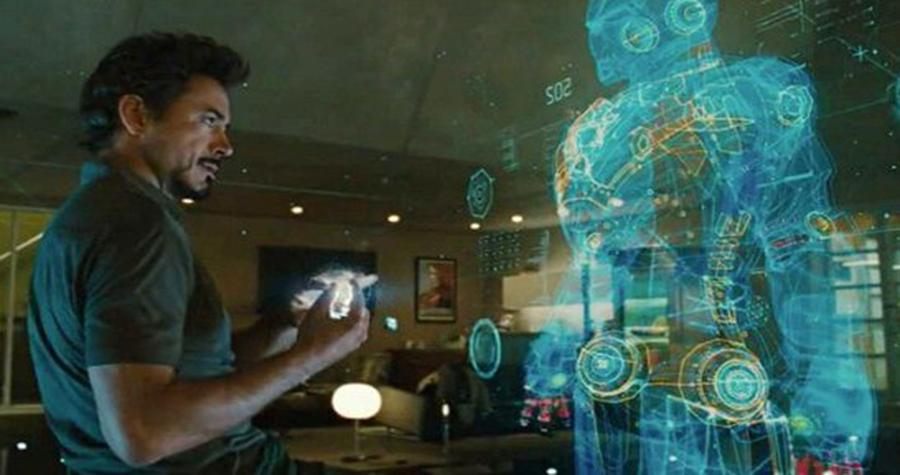We have all dreamed of seeing dinosaurs, or perhaps visiting the pyramids of Egypt, or including ourselves in a scene from our favorite movie. Science has developed thanks to these “dreams”, which in books and movies are called Science and Fiction. Today this technology already exists, and soon we will be able to make those dreams come true thanks to holograms.
What is a hologram?
The Royal Spanish Academy points out that a hologram is “the photographic technique based on the use of coherent light produced by the laser.”
A hologram is a three-dimensional image based on the use of light. To display this image, a laser beam is used that microscopically records a photosensitive film. The interference that occurs between two coherent light beams makes it possible for the light from one of them to reflect off the object. This, upon receiving a point light from the appropriate perspective, projects an image in three dimensions.
When do holograms appear?
The first hologram was a train, and was made in 1962.
The theory of holography was created by the British physicist of Hungarian origin Dennis Gabor in 1947; and for this he received the Nobel Prize in Physics in 1971. In the 1950s, a few articles were published on the subject, however only small and blurry images were obtained.
The researchers lost interest when they did not obtain optimal results when applying the method to the electron microscope. Furthermore, the hologram reconstruction stage was imperfect.
The Gabor method generates an on-axis hologram whose quality is poor due to the overlap of the virtual image and the real or conjugate image. When viewing the virtual or real image, the other image always appears out of focus as the background. In 1955, and after investigating various optical setups to minimize the effect of the conjugate image, Gabor abandoned his research on holography.
However, it was Emmett Leith and Juris Upatnieks, from the University of Michigan, who, after the invention of the laser in 1960, produced the first hologram in 1962. To do so, they used the laser to capture the holographic image of a train with its coherent light. Toy. It remained like this:
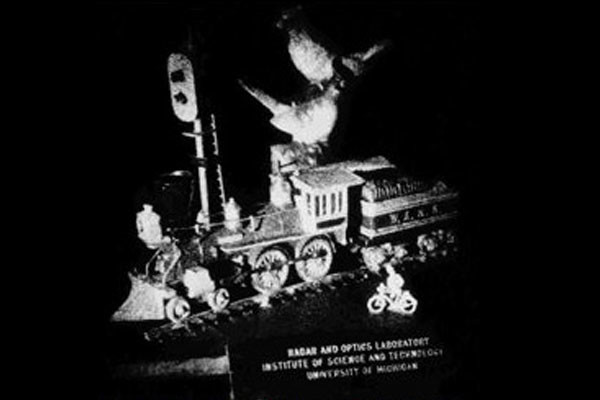
Leith and Upatnieks created this transmission hologram by exposing a black-and-white photographic plate to laser light reflected from a toy model train. The image is reconstructed in three dimensions when coherent laser light shines through the glass.
When they showed this hologram at a conference in April 1964, other scientists lined up to see their progress. “Toy Train” was not the first hologram made in the world in the strict sense. However, the quality of the image surprised everyone, and thus it became the first hologram that many people could see publicly
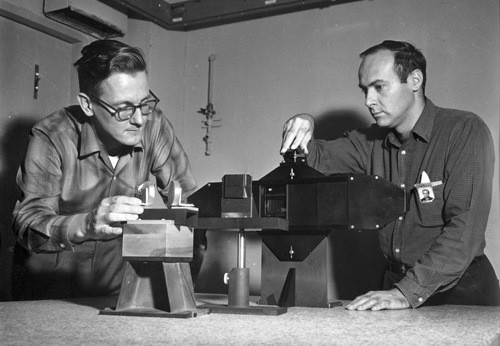
Leith and Upatnieks developed the off-axis reference beam method, which is the most widely used today. This allowed holograms of solid objects to be made by reflected light.
Benton is credited with developing the rainbow hologram. Since it can be copied en masse and seen in incoherent white light, it became the most common type of hologram. Rainbow holograms have appeared on the cover of National Geographic and on millions of credit cards as a counterfeit persuasive.
Examples of holographic devices
Cheoptics 360
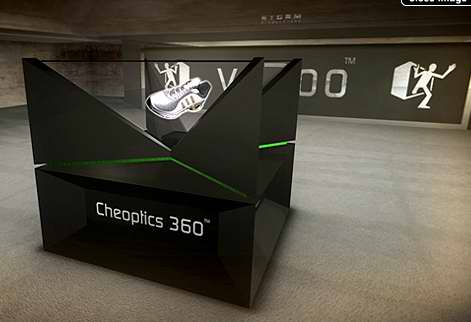
The “Cheoptics 360” device developed by the companies viZoo and Ramboll is a holographic video system. It is a video projector formed by an inverted pyramid that is capable of generating three-dimensional images within its projection space. The projected image is seen fully in 3D from any viewing angle. There are projectors at each end of the device that combine to generate the image in the center giving a feeling of total realism to the viewer. Images can be projected from 1.5 to 30 meters high with any ambient lighting condition (indoor or outdoor).
Heliodisplay
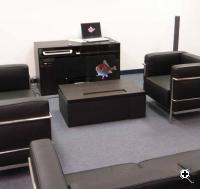
Heliodisplay is a technology created by the company IO2Technology that reproduces 2-D holograms without using a physical medium such as a screen. It allows you to project a static or moving image in the air with a certain quality, about 27 inches, without requiring alternative media such as smoke or water. It can be used in any environment without additional installations.
The device can be described as a box that can be plugged into a USB connector, a video or image source such as a DVD or a personal computer, for example. It uses normal air to operate. What it does is convert the reflection properties of the air. The air is captured, instantly converted and expelled again. The image is projected onto the converted air.
Another important feature is that the generated image is interactive. It is worth saying that the sensation of the image that is projected is not completely three-dimensional. The 3D sensation is only frontal, since when viewed from the side, the image looks flat.
MARK II
It is a holographic video project that is being developed at the Massachusetts Institute of Technology (MIT) by a group of researchers led by Professor S. Benton.
The system is based on the construction of images through a joint exploration of several laser beams whose amplitude is modulated in accordance with the interference fringes of the previously calculated hologram. The scan is carried out using a set of optoacoustic modulators that sweep different horizontal stripes of the image. Images of 150 x 75 x 150 mm can be presented, with a horizontal viewing angle of 36 degrees. It is capable of displaying one image per second.
MARK III
The system called Mark III is an evolution of the holographic devices developed by MIT during the 1980s. Previous systems were very complex and bulky and required specialized hardware to generate the video signal. The objective of the project is to develop a holographic visualization system for the home. It will form monochromatic 3D images with dimensions similar to the Rubik’s cube.
Interactive 360° Light Field Display
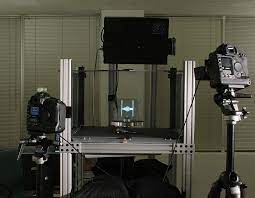
It is a holographic video device developed jointly by Sony, Fake Space Lab and the University of Southern California, presented at SIGGRAPH 2007.
Use of Holograms
Because holograms are very difficult to counterfeit, they have been used on banknotes, credit cards, driver’s licenses, passports and other government-related documents and certificates. For example:
- In the United States, there are high-security holograms on driver’s licenses in many states. Also on postage stamps and on a wide variety of government-related documents and certificates. All new passports have a hologram.
- Since 1994 there has been a hologram on every VISA® and MASTER CARD® card.
- On a five euro bill, on the silver band located on the right side of the obverse, the hologram of Europa (a character from Greek mythology), the € symbol, a window and the value of the bill appear. This gang makes things very difficult for counterfeiters.
- Some museums use holograms of delicate and valuable objects to replace the originals. This is the case of the Lindow Man, a mummy more than 2,300 years old, which is well preserved in a chamber in the British Museum in London. However, her hologram is exposed to both the public and researchers to study.
- The German circus Circus Ronacalli invested more than half a million dollars in 2019 to dispense with the use of real animals and offer a new experience with digital fauna. To achieve this, they combined around 11 top-quality laser projectors, long-range lenses and a group of designers to make a series of animals appear capable of performing any type of acrobatics on stage.

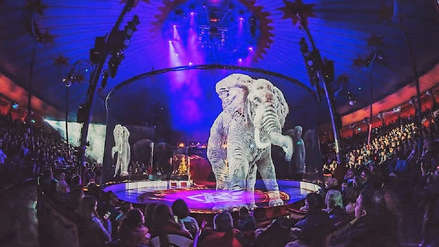
- In 2019, the company Hypervsn presented a holographic version of one of the scenes from the movie “Back to the Future II” at the CES held in Las Vegas. The representation recreated the moment in which the figure of a giant shark pounced on the character of Martin McFly.
- Hatsune Miku is the first hologram singer. This type of hologram works as a 3D image that can be seen without glasses.
In addition to these uses, large projects are currently being developed for the use of holograms in science and entertainment. An example of this are the following technological advances.
- Holograms for medical diagnosis (Published on 8/21/2017): This technology uses very simple optical hardware and a microscope without a lens. Through algorithms, it helps reconstruct tissue samples through images. This hologram-based technique would help patients in remote areas have access to diagnostic tests that are more accessible to others. The method has been developed by Aydogan Ozcan, professor of Electrical and Computer Engineering at UCLA and associate director of the California NanoSystems Institute, and by Rajan Kulkarni and assistant professor of Medicine and Dermatology at the David Geffen School of Medicine at UCLA.
- Japanese scientists create holograms that can be touched (Published on 01/08/2016): The Haptoclone machine makes it possible to generate holograms of real objects that react to human touch. It is also capable of moving the original object according to how its holographic version does. Currently, scientists at the University of Tokyo are developing a machine that allows people to feel and physically interact with holograms generated by this futuristic instrument. This will allow you not only to touch the holographic object or person, but also to move its digital version and, with this, move the original object as well.
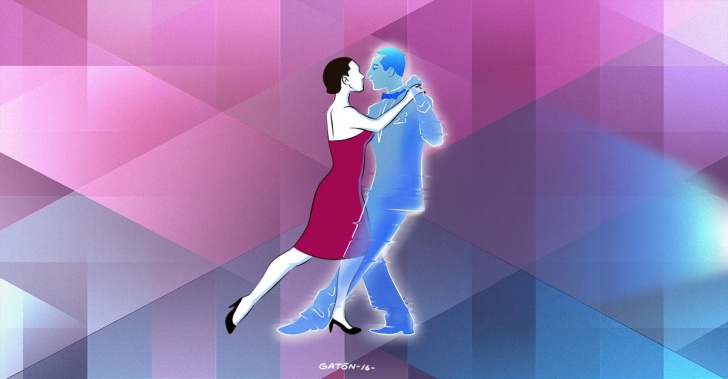
- Puppet theater with holograms (01/03/2018): A short piece for all audiences in which a magical choreography of holographic puppets tells us the story of Hakan and his adventure through dream worlds to recover the light he has lost. Holoqué is the company responsible for this work that combines performing arts with technology.
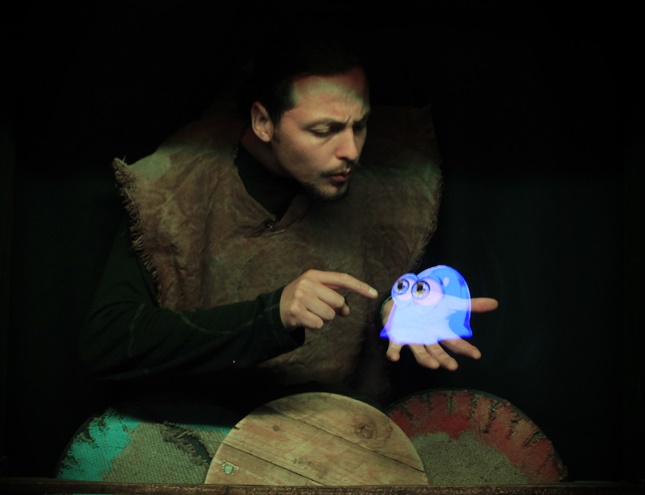
Para finalizar les dejo un video de algunos hologramas. Espero halla sido de su agrado y aprendieran un poco más sobre la historia y utilización de los hologramas.


